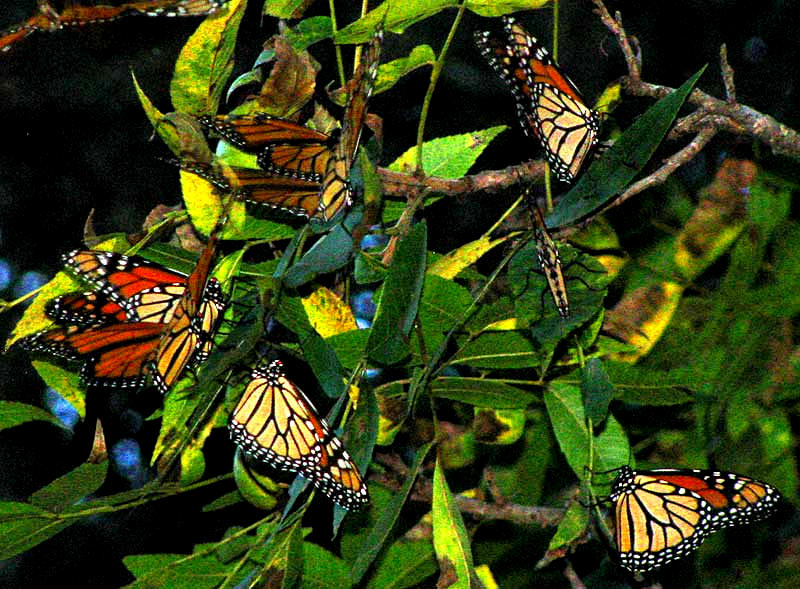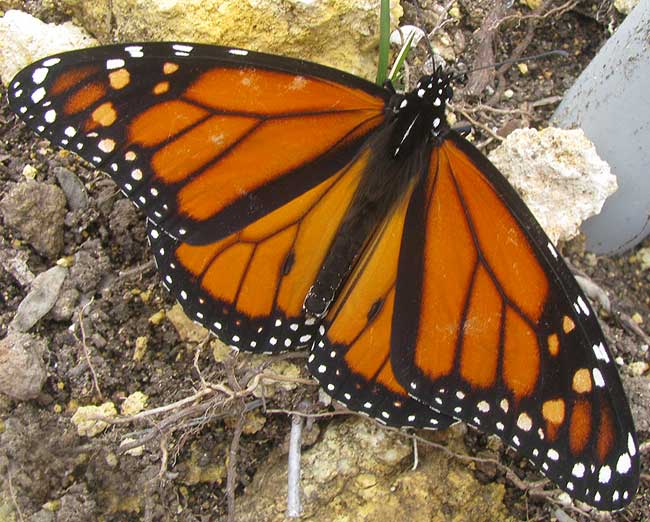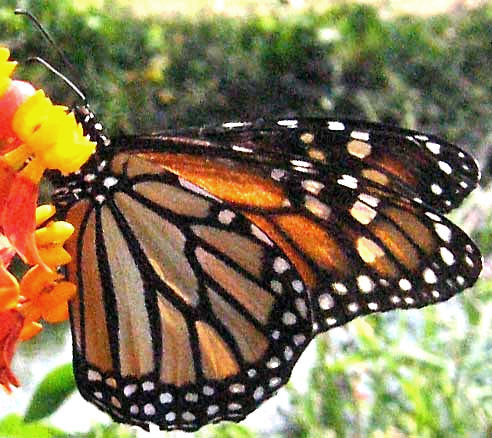Excerpts from Jim Conrad's
Naturalist Newsletter

from the October 14, 2012 Newsletter issued from the valley of the Dry Frio River in northern Uvalde County, southwestern Texas, on the southern border of the Edwards Plateau; elevation ~1750m (~5750 ft); N29.62°, W99.86°; USA
MONARCH BUTTERFLIES MIGRATING THROUGH TEXAS
Friday at dusk Malle and I were picking pecans from trees along the little Dry Frio River. When it got so dark we could hardly see the clusters of nuts on the branches we noticed a certain fluttering above our heads, which turned out to be Monarch butterflies. I'd not seen a single Monarch in this area since I've been here but suddenly here were about a dozen flying in and out of the tree's deep shadows as if checking things out.
Monarchs occur in Texas only during their migrations, for their summer distribution area lies well to the north of us. These were definitely migrants who clustered in a way I've only seen them do in their wintering grounds in the highlands of central Mexico. You can see several clustering in a flash-enhanced picture at the top of this page.
It turns out that Uvalde County lies in the center of the Monarchs' Central Flyway and that historically the peak of their migration here occurs on about October 18th. These were seen on October 12th. An excellent page with many links to Monarch matters, and maps showing Texas' flyways and when the migration peaks occur is at http://www.texasento.net/fall_peak.htm.
An online article about the decline of Monarchs and the problems they face is online at https://www.sciencedaily.com/releases/2012/03/120321172210.htm.
In that 2012 story it's stated that this year Monarchs covered about 7.14 acres (2.9 hectares) of forest in their Mexican breeding grounds compared to 9.9 acres (4.0 hectares) last year, continuing a long-term downward trend in the Monarch population since official surveys began in 1994.
I wonder if we will be seeing these wonderful butterflies much longer?
from the December 8, 2013 Newsletter issued from the Frio Canyon Nature Education Center in the valley of the Dry Frio River in northern Uvalde County, southwestern Texas, on the southern border of the Edwards Plateau; elevation ~1750m (~5750 ft); N29.62°, W99.86°; USA
POUCHES ON MALE MONARCHS
On the last day of November a male Monarch Butterfly made a very late-season appearance here just below Juniper House. That's him below:

It's easy to see that he's a male because not only are the black veins on a female's hind wings much thicker than these, but also because of the single black dot on each hind wing. Hind wings on females don't bear those dots.
The black dots are small pouches in which pheromones are produced, pheromones being chemicals secreted by animals, especially insects, that influence the behavior or development of others of the same species. Pheromones often function as attractants of the opposite sex.
In 1951 Sibyl Hausman published an article in The American Naturalist, Vol. 85, No. 825, entitled "The Scent-producing Organ of The Male Monarch." She described the gland as a slightly elevated black pouch covered with dark scales. The inner cavity is lined with tiny, black, overlapping "scent scales," or "androconia," androconia meaning "male dust." The inner wall is thin, yellowish and arrayed with tiny "scent cups," each cup of which is covered with a tiny cuticle bearing a central pore from which extends an extremely fine, hairlike scale. Between the cups are pits from which arise a kind of wider scale. The two scale types give off characteristic odors. The secretory substance has a faint, fragrant odor like that of sweet milkweed blossoms.
There's sort of a poetry here: The female lays eggs on milkweed plants, since that's what Monarch caterpillars feed on, and the male emits his pheromone smelling of the flowers she is programmed to crave.
entry dated March 24, 2023, issued from near Tequisquiapan; elevation about 1,900m, (6200 ft), ~N20.57°, ~W99.89°; Querétaro state, MÉXICO
MONARCH MIGRATION IN UPLAND CENTRAL MEXICO

After a winter of three or four frosts, the Monarchs have been appearing in this area for several days. Mostly they're seen among thickets of Smooth Mesquites, Prosopis laevigata, apparently taking nectar from the flowers. The mesquites are at their peak of flowering now. Typically only one or two occur in a tree, sometimes five or more. You don't see them here either during the cool dry season, the northern winter, or the warm rainy season, just during migrations. At certain times you can see them suddenly leave the mesquites and climb into the sky, trending northward, so high and far away that soon they're lost to sight.
A little pond beside a row of mesquites was covered with a scum of Brazilian Watermeal and fallen mesquite flowers. A Monarch circled over the pond a few times, then alighted atop the scum:

The Monarch's back wings dipped into the water, but the butterfly stayed there, apparently drinking, for a couple of minutes. Then it flew away showing no indication of dampened wings, toward the north.
from the March 3, 2008 Newsletter Written in the community of 28 de Junio and issued from a ciber 8 kms to the west in Pujiltic, the hot, arid, lowland Central Valley of Chiapas, MÉXICO
MONARCH BUTTERFLIES IN CHIAPAS'S CENTRAL VALLEY
Monarch Butterflies are common here, one being shown below.

I doubt that the individual in the photo will ever migrate to North America, though. My understanding is that US and Canadian migrants overwinter on cool, moist, forested mountaintops far north of here, in central Mexico. Our populations don't make the trip.
One reason Monarchs are so common here is that their host plants, the milkweeds, also are common, especially the species whose yellow and orange blossoms are being visited in the picture. That's ASCLEPIAS CURASSAVICA, sometimes known as the Tropical Milkweed. It's a native of South America but is now established in disturbed, weedy places throughout much of the world's tropics and subtropics, including all through Mexico.
from the March 8, 2005 Newsletter issued from "Cyber El Profe" in Pantepec, Chiapas, Mexico
MONARCH BUTTERFLIES IN HIGHLAND CHIAPAS, SOUTHERN MEXICO
I've seen many Monarch Butterflies here, often visiting the red-and-orange-flowered milkweed ASCLEPIAS CURASSAVICA, commonly found blossoming now in pastures and along roadsides.
I mention this because I only recall seeing reference to Monarchs overwintering in the highlands of central Mexico, not here in the south far from the Monarch reserves. The lowlands of the Isthmus of Tehuantepec lie between here and the central Mexican highlands.
I would like to think that many Monarchs overwinter in places other than the Monarch reserves I have visited in central Mexico, because those reserves, like the forests here, are being gnawed away by firewood gatherers and cattle farmers.
Am I seeing something new or unreported with regard to overwintering Monarch Butterflies? I'd like to hear from anyone who knows.
from the November 15, 2005 Newsletter written at Hacienda San Juan Lizarraga one kilometer east of Telchac Pueblo, Yucatán, MÉXICO
and issued from Hotel Reef Yucatan 13 kms to the north
MONARCH BUTTERFLIES IN THE YUCATAN
You might recall that this spring I reported seeing Monarch Butterflies in upland Chiapas, Mexico's southernmost state. Since arriving here I've seen dozens in the Yucatan.
This has surprised me because every magazine article and film I've ever seen about Monarchs focused on the story of their migration between North America and certain mountaintops in central Mexico. That doesn't explain the butterflies' occurrence in Chiapas and here, far south of the central Mexican mountaintops.
I wrote to Chip Taylor at https://www.monarchwatch.org/ and he explained the situation with a single sentence: "Monarchs occur as far south as Venezuela."
He went on, " Monarchs can be found in most of lowland and mid elevation Mexico - wherever the tropical milkweed is found."
I'm glad to hear about this very large distribution area for Monarchs because I've visited some of those central Mexican mountaintops where overwintering Monarchs hang by the millions from trees, and my impression is that those "sanctuaries" are very much endangered -- mainly by local firewood gatherers and timber cutters, farmers wanting land, and by changing microclimates inside the sanctuaries, because of forest removal outside the sanctuaries' boundaries. If North America's Monarchs depend on Mexico's sanctuaries, then either the sanctuaries need more protection or North Americans shouldn't plan on having Monarchs for long.
However, now it's clear that even if the central Mexican sanctuaries are destroyed, at least some Monarchs will survive. I'm unclear as to whether those Monarchs who overwinter from here to Venezuela migrate to North America, or migrate at all.